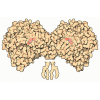Entry Database : EMDB / ID : EMD-38420Title Cryo-EM structure of human insulin receptor bound to 4 IGF-I, conformation 3 Complex : The complex of insulin receptor with 4 IGF-IProtein or peptide : Isoform Short of Insulin receptorProtein or peptide : Insulin-like growth factor IFunction / homology Function Domain/homology Component
/ / / / / / / / / / / / / / / / / / / / / / / / / / / / / / / / / / / / / / / / / / / / / / / / / / / / / / / / / / / / / / / / / / / / / / / / / / / / / / / / / / / / / / / / / / / / / / / / / / / / / / / / / / / / / / / / / / / / / / / / / / / / / / / / / / / / / / / / / / / / / / / / / / / / / / / / / / / / Biological species Homo sapiens (human)Method / / Resolution : 5.0 Å Xi Z Funding support Organization Grant number Country National Natural Science Foundation of China (NSFC)
Journal : To Be Published Title : Cryo-EM structure of human insulin receptor bound to 4 IGF-I, conformation 3Authors : Xi Z History Deposition Dec 23, 2023 - Header (metadata) release Dec 25, 2024 - Map release Dec 25, 2024 - Update Jun 18, 2025 - Current status Jun 18, 2025 Processing site : PDBj / Status : Released
Show all Show less
 Yorodumi
Yorodumi Open data
Open data Basic information
Basic information
 Map data
Map data Sample
Sample Keywords
Keywords Function and homology information
Function and homology information Homo sapiens (human)
Homo sapiens (human) Authors
Authors China, 1 items
China, 1 items  Citation
Citation Journal: To Be Published
Journal: To Be Published Structure visualization
Structure visualization Downloads & links
Downloads & links emd_38420.map.gz
emd_38420.map.gz EMDB map data format
EMDB map data format emd-38420-v30.xml
emd-38420-v30.xml emd-38420.xml
emd-38420.xml EMDB header
EMDB header emd_38420.png
emd_38420.png emd_38420_msk_1.map
emd_38420_msk_1.map Mask map
Mask map emd-38420.cif.gz
emd-38420.cif.gz emd_38420_half_map_1.map.gz
emd_38420_half_map_1.map.gz emd_38420_half_map_2.map.gz
emd_38420_half_map_2.map.gz http://ftp.pdbj.org/pub/emdb/structures/EMD-38420
http://ftp.pdbj.org/pub/emdb/structures/EMD-38420 ftp://ftp.pdbj.org/pub/emdb/structures/EMD-38420
ftp://ftp.pdbj.org/pub/emdb/structures/EMD-38420 emd_38420_validation.pdf.gz
emd_38420_validation.pdf.gz EMDB validaton report
EMDB validaton report emd_38420_full_validation.pdf.gz
emd_38420_full_validation.pdf.gz emd_38420_validation.xml.gz
emd_38420_validation.xml.gz emd_38420_validation.cif.gz
emd_38420_validation.cif.gz https://ftp.pdbj.org/pub/emdb/validation_reports/EMD-38420
https://ftp.pdbj.org/pub/emdb/validation_reports/EMD-38420 ftp://ftp.pdbj.org/pub/emdb/validation_reports/EMD-38420
ftp://ftp.pdbj.org/pub/emdb/validation_reports/EMD-38420
 F&H Search
F&H Search Links
Links EMDB (EBI/PDBe) /
EMDB (EBI/PDBe) /  EMDataResource
EMDataResource Map
Map Download / File: emd_38420.map.gz / Format: CCP4 / Size: 512 MB / Type: IMAGE STORED AS FLOATING POINT NUMBER (4 BYTES)
Download / File: emd_38420.map.gz / Format: CCP4 / Size: 512 MB / Type: IMAGE STORED AS FLOATING POINT NUMBER (4 BYTES) emd_38420_msk_1.map
emd_38420_msk_1.map Sample components
Sample components Homo sapiens (human)
Homo sapiens (human) Homo sapiens (human)
Homo sapiens (human) Homo sapiens (human)
Homo sapiens (human) Homo sapiens (human)
Homo sapiens (human)
 Processing
Processing Sample preparation
Sample preparation Electron microscopy
Electron microscopy FIELD EMISSION GUN
FIELD EMISSION GUN
 Movie
Movie Controller
Controller


















 Z (Sec.)
Z (Sec.) Y (Row.)
Y (Row.) X (Col.)
X (Col.)












































